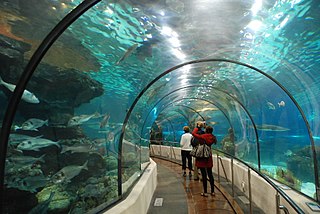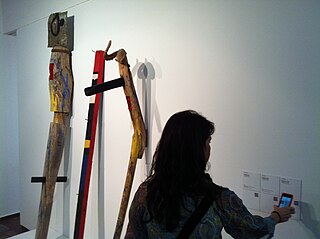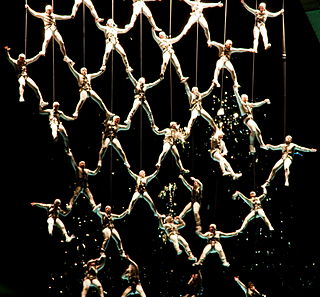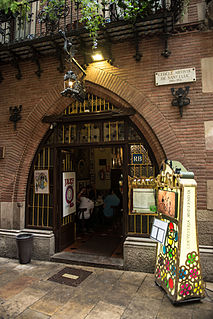 W
WBarcelona's culture stems from the city's 2000 years of history. To a greater extent than the rest of Catalonia, where Catalonia's native Catalan is more dominant, Barcelona is a bilingual city: Catalan and Spanish are both official languages and widely spoken. Since the arrival of democracy, the Catalan culture has been promoted, both by recovering works from the past and by stimulating the creation of new works.
 W
WThe Reial Acadèmia de Bones Lletres de Barcelona is a Catalan literary society, based in Barcelona. It was founded in 1729 and it has its headquarters since 1902 in the Palau Requesens in Barcelona's Gothic Quarter.
 W
WAquarium Barcelona is an aquarium located in Port Vell, a harbor in Barcelona, Catalonia, Spain.
 W
WL'Auditori is a modern building of 42,000 square metres designed by the architect Rafael Moneo, opened on 22 March 1999, in Barcelona, Catalonia, Spain. It is in the centre of the new pole of urban development of Plaça de les Glòries, which brings together the three widest and longest avenues in the city near the old centre of the city, its ‘Avenue’, next to the National Theatre, Glòries junction, the opening of the Diagonal on to the sea, district 22@ and the Forum area.
 W
WThe Barcelona International Erotic Film Festival or FICEB is an annual Spanish pornographic film festival and awards ceremony. It is the oldest adult film festival in Europe.
 W
WBrazzaville is an American indie pop band founded in 1997 by David Brown. Brown was at one time Beck's saxophonist and took part in recording of Odelay and Midnite Vultures. On May 7, 2009, David Brown officially announced the dissolution of the band, stating that he would henceforth be recording and releasing music under the name David Arthur Brown, albeit with "many of the wonderful musicians who have contributed to Brazzaville records." However, June 23, 2009, David once again announced that the band will continue to exist in parallel with a solo career.
 W
WCan Batlló, or the old Joan Batlló Factory is a former industrial complex located close to the Gran Via de les Corts Catalanes, near the square known as Plaça Cerdà. It is composed of the facilities set up for the textile factory created in 1878 by Joan Batlló i Barrera. Towards the end of the 19th century it livened up the La Bordeta neighbourhood in Barcelona. The project was the work of engineer Juan Antonio Molinero.
 W
WCasa Bonaventura Ferrer is a building located at number 113 of Passeig de Gràcia in Barcelona, Catalonia, Spain, and rear facade at number 6 in the Riera de Sant Miquel. It is a project of the architect Pere Falqués i Urpí following a Modernisme or Art Nouveau style, being erected in 1906.
 W
WThe April Fair of Catalonia,, is an annual event held in the Catalan capital of Barcelona, Spain. It usually takes place over the last week of April and the first week of May.
 W
WThe Centre de Cultura Contemporània de Barcelona is an arts centre in Barcelona, Catalonia, Spain.
 W
WThe coat of arms of Barcelona is the official emblem of the City Council of Barcelona, the capital of Catalonia, has its origin in the Middle Ages, these arms were first documented in 1329. The Government of Catalonia conferred the coat of arms and the flag as official symbols of the municipality in 2004. It has an escutcheon in lozenge which is commonly used in municipal coats of arms of cities in Catalonia. Currently the City Council of Barcelona also uses an isotype based on the heraldry of the city.
 W
WConservatori Superior de Música del Liceu is a music college in Barcelona, Catalonia, Spain. It was created in 1837 with the name Liceo Filo-dramático de Montesión.
 W
WJoan Cornellà Vázquez is a Spanish cartoonist and illustrator, famous for his unsettling, surreal humor and black humor comic strips as well as artwork.
 W
WThe 1888 Barcelona Universal Exposition was Spain's first International World's Fair and ran from April 8 to December 9, 1888. It was also the first of the two held in Barcelona.
 W
WThe Festival Grec de Barcelona is an international theatre, dance, music and circus festival. Over the course of its history, this long-standing event has become a major summer attraction in Barcelona.
 W
WThe flag of Barcelona is the municipal flag of Barcelona, which combines the cross of Saint George, the patron saint of Catalonia, with the traditional red and yellow bars of the Senyera, the ancient symbol of the Crown of Aragon.
 W
WThe Free Culture Forum (FCForum) is an ian international meeting of relevant organisations and individuals involved in free culture, digital rights and access to knowledge. It has been taking place in Barcelona every year since 2009, jointly with the oXcars, a free culture festival.
 W
WGaleries Dalmau was an art gallery in Barcelona, Spain, from 1906 to 1930. The gallery was founded and managed by the Symbolist painter and restorer Josep Dalmau i Rafel. The aim was to promote, import and export avant-garde artistic talent. Dalmau is credited for having launched avant-garde art in Spain.
 W
WHer Majesty the Queen is an object-sculpture made by Joan Miró in 1974 and now part of the permanent collection of the Joan Miró Foundation in Barcelona.
 W
WHis Highness the Prince is an object-sculpture made by Joan Miró in 1974 and now part of the permanent collection of the Joan Miró Foundation in Barcelona.
 W
WHis Majesty the King is a sculpture-object made by Joan Miró in 1974 and now part of the permanent collection of the Fundació Joan Miró in Barcelona.
 W
WThe former Hospital de la Santa Creu i Sant Pau in the neighborhood of El Guinardó, Barcelona, Catalonia, Spain, is a complex built between 1901 and 1930, designed by the Catalan modernisme architect Lluís Domènech i Montaner. Together with Palau de la Música Catalana, it is a UNESCO World Heritage Site.
 W
WLa Fura dels Baus is a Spanish theatrical group founded in 1979 in Moià, Barcelona (Spain), known for their urban theatre, use of unusual settings and blurring of the boundaries between audience and actor. "La Fura dels Baus" in Catalan means "The ferret from Els Baus". According to a 1985 review of their London performance, published in NME, the group "create a kind of adult adventure playground of fun, danger, slapstick and fantasy".
 W
WThis is a list of theatres and concert halls in Barcelona, Catalonia, Spain, and its surrounding metropolitan area.
 W
WLa Mercè is the annual festival of the city of Barcelona in Catalonia, Spain. It has been an official city holiday since 1871, when the local government first organized a program of special activities to observe the Roman Catholic feast day of Our Lady of Mercy, La Mare de Déu de la Mercè in Catalan. Although the actual feast day is September 24, the festivities begin a few days beforehand.
 W
WThe Orfeó Català is a choral society based in Barcelona, Catalonia, Spain, which was founded in 1891 by Lluís Millet and Amadeu Vives.
 W
WThe Orquestra Pau Casals was established by Pablo Casals in the early 1920s in Barcelona, with the debut performance taking place October 13, 1920. There had been other orchestras in Barcelona, but none that played with any enduring success. The orchestra was managed by a group of Casals' friends including Felip Capdevila and Casals' second wife Francesca.
 W
WPalau Robert is a building on Barcelona's Passeig de Gràcia 107, the former private residence of Robert Robert i Surís, an influential aristocrat, politician and businessman at the turn of the 20th century. It's now a government-run institution that hosts an exhibition centre with three halls, a concert hall, a public swimming pool and gardens as well as the Information Centre for Catalonia, including the city's tourism bureau. In the 1936–1939 period, it was the site of the Generalitat de Catalunya's Ministry of Culture. After the Spanish Civil War, Robert's family regained the Palau, until its second purchase by the Generalitat de Catalunya in 1981, when it became a public building.
 W
WParc de la Creueta del Coll is a park in the Gràcia and Horta districts of Barcelona, Catalonia, Spain. The park was created from an abandoned quarry as part of the nou urbanisme developments during the 1992 Summer Olympics by architects Martorell, Bohigas and Mackay.
 W
WParc Güell is a privatized park system composed of gardens and architectural elements located on Carmel Hill, in Barcelona, Catalonia, Spain. Carmel Hill belongs to the mountain range of Collserola – the Parc del Carmel is located on the northern face. Park Güell is located in La Salut, a neighborhood in the Gràcia district of Barcelona. With urbanization in mind, Eusebi Güell assigned the design of the park to Antoni Gaudí, a renowned architect and the face of Catalan modernism.
 W
WEls Quatre Gats is a café in Barcelona, Catalonia, Spain that famously became a popular meeting place for famous artists throughout the modernist period in Catalonia, known as Modernisme. The café opened on June 12, 1897 in the famous Casa Martí, and served as a hostel, bar and cabaret until it eventually became a central meeting point for Barcelona’s most prominent modernist figures, such as Pablo Picasso and Ramon Casas i Carbó. The bar closed due to financial difficulties in June 1903, but was reopened and eventually restored to its original condition in 1989.
 W
WThe Royal Barcelona Yacht Club is a member-only yacht club based in Barcelona. It was established in 1876 and is one of the oldest yacht clubs in Spain.
 W
WThe Reial Acadèmia Catalana de Belles Arts de Sant Jordi is a Catalan art school located in Barcelona. The president is the architect Jordi Bonet i Armengol.
 W
WRinzen is an sculpture by Antoni Tàpies conserved at MACBA, the Contemporary Art Museum of Barcelona.
 W
WSaint George's Day is celebrated on April 23rd but festivities may also begin on the eve of his feast day, on April 22nd.
 W
WThe Sala Parés is the oldest art gallery in Barcelona, Spain. Initially an art store, established in 1840 by Joan Parés, it slowly evolved into a gallery and formally became one in 1877.
 W
WManga Barcelona, formerly known until 2018 as Saló del Manga de Barcelona is a Spanish anime and manga convention held annually in Barcelona, and is the largest anime convention in Spain and the second largest in all Europe.
 W
WThe Sarajevo Haggadah is an illuminated manuscript that contains the illustrated traditional text of the Passover Haggadah which accompanies the Passover Seder. It is one of the oldest Sephardic Haggadahs in the world, originating in Barcelona around 1350. The Haggadah is owned by the National Museum of Bosnia and Herzegovina in Sarajevo. Its monetary value is undetermined, but a museum in Spain required that it be insured for $7 million before it could be transported to an exhibition there in 1992.
 W
WSónar is an arts, design, and electronic and experimental music festival, founded in Barcelona in 1994 by Ricard Robles, Enric Palau, and Sergi Caballero. The festival has been divided into two parts since its inception: Sónar by Day and Sónar by Night, with a three-day congress dedicated to Creativity, Technology and Business running concurrently since 2013. As well as the flagship event in Barcelona, Sónar hosts events around the world, with annual festivals currently taking place in Bogota, Buenos Aires, Hong Kong, Reykjavik and Istanbul.